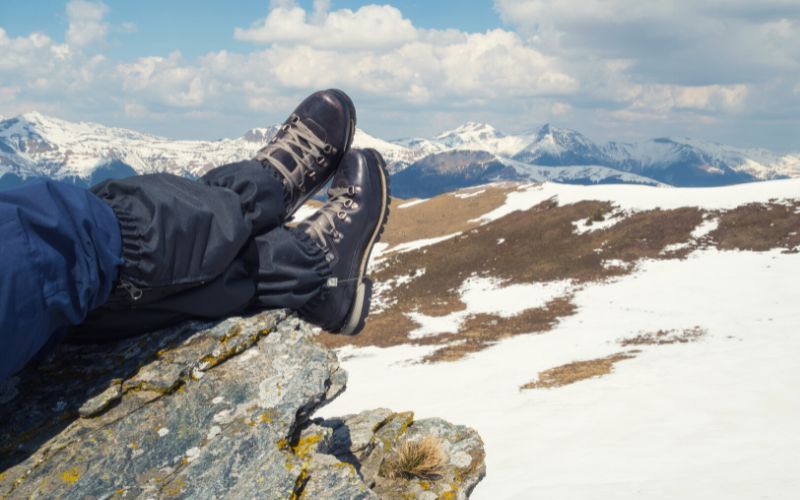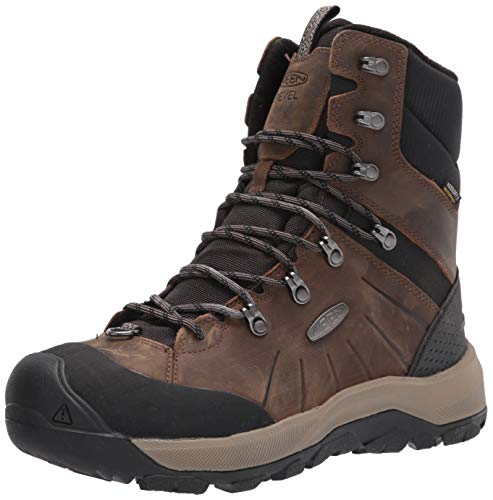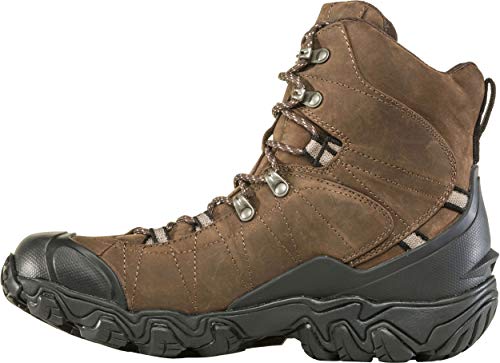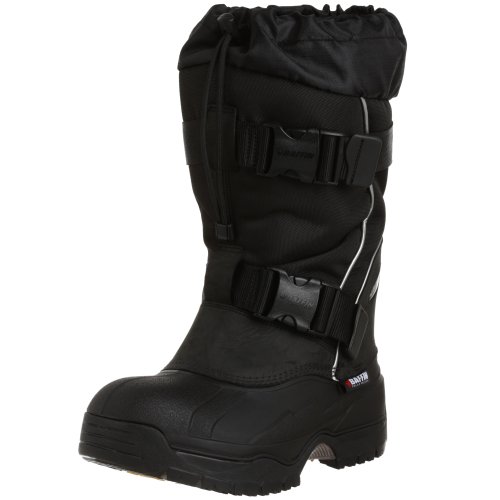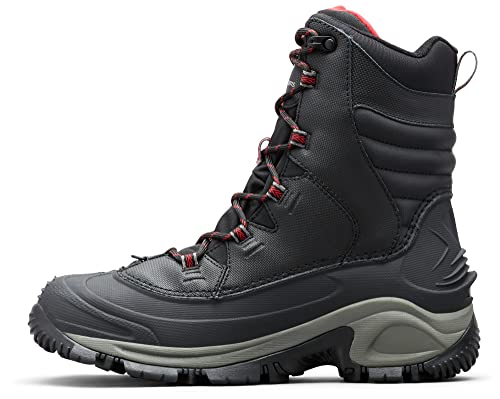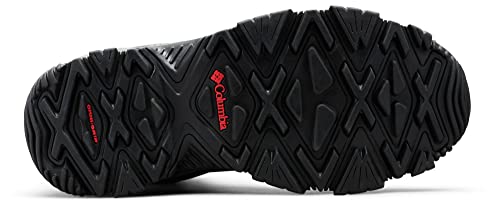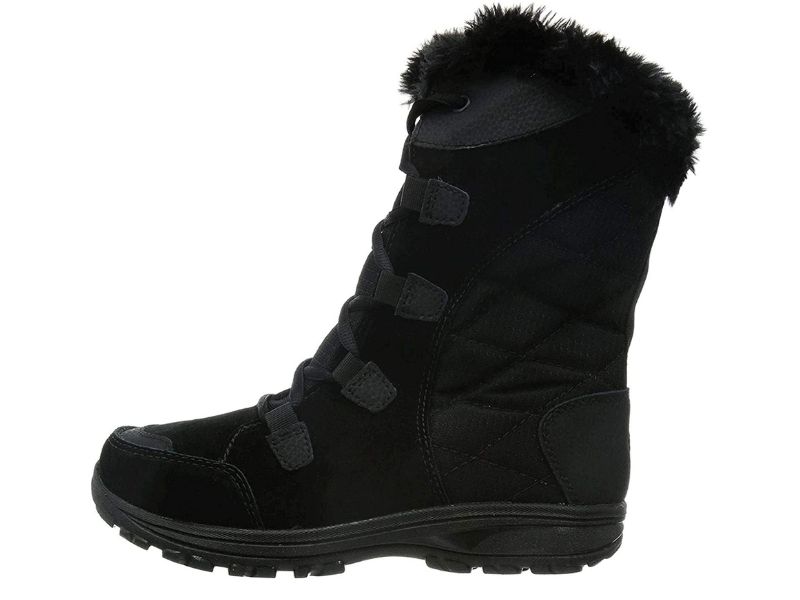If you’ve tried snowshoeing in regular footwear, you’ve learned the hard way that keeping your feet warm, comfortable, and injury-free requires wearing something more substantial and specific to the task. To help you find that “something,” we’ve compiled a list of 9 top choices for snowshoe-compatible boots.
The boots on this list range from budget buys to top-end models for extreme environments, with options for both men and women. Our top pick is the Keen Revel IV Polar, followed by the Oboz Bridger, Baffin Impact Winter Boot, Vasque Breeze WT GTX, Columbia Bugaboot III, Merrell Thermo Chill Mid, KEEN Women’s Greta Waterproof Chelsea, The North Face Chilkat 400, and Columbia Women’s Ice Maiden II.
Below our reviews, you’ll find detailed buying advice to help you choose the best option for your needs. Features such as insulation, waterproofing, support, breathability, and weight are all important considerations when buying winter boots for hiking and snowshoeing. Lastly, we touch upon the three main types of snowshoes designed for flat terrain, rolling terrain, and mountain terrain.
Table of Contents
- Snowshoeing Footwear: Quick Recommendations
- Snow Hiking Shoe by Category
- What Are The Best Boots for Snowshoeing?
- How Do Hiking Boots Differ From Snowshoe / Winter Boots?
- What To Look For In Snowshoeing Boots?
- Are There Different Types of Snowshoes?
- Best Winter Boots For Hiking And Snowshoeing: The Verdict
Snowshoeing Footwear: Quick Recommendations
-
Editor’s Choice:
KEEN Revel IV Polar
“Performs well in every important metric and offers great value for money to boot.” -
Best Value:
Oboz Bridger
“Stylish, warm, waterproof, and more versatile than most competitors.” -
Best for Warmth:
Baffin Impact Winter Boot
“Overkill for some, but ideal in truly frigid conditions.” -
Best Gore-Tex:
Vasque Breeze WT GTX
“A relatively lightweight, waterproof, and highly breathable boot that’s ideal for snowshoers who live to move fast.” -
Bargain Buy:
Columbia Bugaboot III
“Offer the most warmth per dollar of all the boots we tested.” -
Best Budget:
Merrell Thermo Chill Mid
“A versatile boot that offers a little less support than others but is otherwise mightily impressive.” -
Best Women’s:
KEEN Women’s Greta Waterproof Chelsea
“An incredibly well-made and comfortable slip-on boot that’s comfort rated down to -25°F.” -
Runner Up Women’s:
The North Face Chilkat 400
“Toasty warm and pillow-like feel for your feet.” -
Women’s Budget Pick:
Columbia Women’s Ice Maiden II Snow Boots
“Less technical but plenty warm for the needs of most users and offers outstanding value for money.”
Snow Hiking Shoe by Category
Budget: Columbia Bugaboot III, Columbia Ice Maiden II, Merrell Thermo Chill Mid
Men’s: KEEN Revel IV Polar, Baffin Impact, Vasque Breeze WT, Merrell Thermo Chill Mid
Women’s: KEEN Revel IV Polar, KEEN Women’s Greta Waterproof Chelsea, Oboz Bridger, Columbia Ice Maiden II, The North Face Chilkat 400
What Are The Best Boots for Snowshoeing?
The following list contains our top choices for snowshoeing boots, available for both men and women.
- Keen Revel IV Polar
- Oboz Bridger
- Baffin Impact Winter Boot
- Vasque Breeze WT GTX
- Columbia Bugaboot III
- Merrell Thermo Chill Mid
- KEEN Women’s Greta Waterproof Chelsea
- The North Face Chilkat 400
- Columbia Women’s Ice Maiden II Snow Boots
Keen Revel IV Polar
Editor’s ChoiceWe chose the Keen Revel IV Polar, also available in a women’s version, as the best snowshoeing boots for this year. These boots are warm, breathable, waterproof, supportive and offer great value.
They’re also relatively lightweight, warm enough for frigid climates, waterproof, agile, supportive, and fairly priced. Importantly, we also found these the most comfortable of the bunch after several hours of traipsing on the trails.
The Revel IV Polar uses 400g of KEEN.WARM recycled insulation and are comfort rated to -40°F/-40°C by the brand. While we believe this rating might be a bit of a stretch (and will vary from person to person), we found them to be among the warmest options on our list, after the Baffin Impact.
The Revel IV also have a KEEN.DRY waterproof-breathable membrane to complement the all-leather uppers and a PFC-free DWR coating, so they’re standout performers in slushy snow or otherwise wet conditions.
These aren’t the most lightweight boots on our list, granted, but they’re a great pick if protection and warmth are higher on your list of priorities.
PROs
- 400g of KEEN.WARM recycled insulation
- Rated to -40°F/-40°C
- Thermal Heat Shield insole captures warmth
- Very comfortable
- Roomy toe box
CONs
- A touch heavy
Bottom-Line: Tough, well-made, uber-comfortable waterproof boots that are warm enough for frigid climates and breathable enough for spring snowshoeing adventures in most areas.
Oboz Bridger
Best ValueThe Oboz Bridger, also available in a 7” women’s version, are great value as well as the most versatile boot on our list. Besides being an excellent snowshoeing boot, it’s stylish and agile enough to wear around town or as winter boots on regular cold-season hikes.
The upper material of the Bridger is made from a classy-looking nubuck leather, 200g of 3M Thinsulate insulation, and an Oboz B-DRY waterproof/breathable membrane sandwiched in between. This combo makes them waterproof, supportive, and warm enough for temps of 15-35 °F. There’s also a burly rubber toe cap to protect your tootsies against your snowshoe binding mechanism.
Underfoot, things are equally impressive. A single-density EVA midsole provides a cushy feel and plenty of arch support, while the OFit Thermal wool-topped insoles insulate the bottom of your feet. The Granite Peak outsole, meanwhile, is made with special winterized rubber that is infused with silica to improve your grip on icy surfaces (ideal for the approach!).
PROs
- A tree is planted for every pair sold
- Insulated sole
- Waterproof
- Cushy midsole
CONs
- All-leather upper makes them less breathable than some
Bottom-Line: Stylish, waterproof, warm, and as comfortable as they come.
Baffin Impact Winter Boot
Best for WarmthIf you tend to snowshoe in extremely cold weather the Baffin Impact, also available in a women’s version, is the warmest boot in the biz.
The Baffin Impact are comfort-rated down to -148°F, making them the warmest boot on our list by a long way. Given the lowest temperature ever recorded on Earth was -128.6°F, these should have you covered for all eventualities unless you’re planning a spot of space travel.
Warmth aside, the Impact has a shedload going for them. The upper and outer boot reaches about ¾ of the way up the shin, providing added insulation for your lower legs. This part of the boot is made with a combo of ripstop nylon and leather, too, so it’s tough as nails.
The Baffin also has nice, springy EVA midsoles and nylon shanks that support the arches and help to prevent foot fatigue, and an aggressive outsole that will keep you upright when slogging over ice and slush before and after putting on your snowshoes.
And the downsides? Well, with all that insulation, the Baffin are sure to be overkill for some, and their 7.42 lbs. weight means they’ll give your legs a serious workout.
PROs
- Ideal in extreme cold (comfort-rated down to -148°F!)
- Removable inner boot
- Ripstop nylon and leather upper
- Knee-height cut
- Surprisingly comfortable
CONs
- Pricey!
Bottom-Line: Will keep your feet toasty no matter where you choose to take them.
Vasque Breeze WT GTX
Best Gore-TexThe Basque Breeze, also available in a women’s version, is our top Gore-Tex pick.
The Breeze are blessed with 200g of Thinsulate insulation, so are warm enough to keep your feet toasty in temps down to around -20°F. However, courtesy of a Gore-Tex waterproof-breathable membrane and air-mesh panels in the uppers they breathe better than any other boot on our list.
The Breeze WT’s lightweight insulation and ventilation also make them highly versatile. When you’re not wearing them on snowshoeing trips, they’ll serve you well on cold winter hikes or days around town.
The Vibram® Contact Grip Megagrip outsoles also mean the Breeze provides plenty of traction and grip in sketchy underfoot conditions, while the all-terrain EVA midsoles provide plenty of cushioning and the more rigid PU shanks provide more support and underfoot protection when moving in rougher terrain.
PROs
- Relatively lightweight
- Grippy Vibram outsole
- Comfortable
- Waterproof and breathable
CONs
- Not as warm as the alternatives
Bottom-Line: Highly versatile the Breeze WT will serve as waterproof hiking boots as well as breathable snowshoes.
Columbia Bugaboot III
Bargain BuyThe Columbia Bugaboot III, also available in a women’s version, is a good choice for occasional snowshoers seeking an affordable option that doubles as a winter hiking boot. While not the warmest, tallest, or toughest on our list, its versatility and high-quality construction, make it an absolute steal.
This is one of the only boots on our list that doesn’t have a waterproofed membrane, but the all-leather uppers and injection-molded shell provide robust enough waterproofing for excursions in all but extremely soggy snow.
The Bugaboot III uses 200g of, Omni Heat, synthetic insulation and we reckon they’d be good in temps down to around -25°F if moving slow, and a little lower if you run warm or tend to move fast. They also have a cushy Techlite midsole and a beefy rubber outsole that provides great traction.
At 24.5 oz per pair (size 9), the Bugaboot is also one of the lightest insulated boots on our list.
PROs
- Warm for such a lightweight boot
- Available in wide sizes
- Affordable
- Comfortable
- Thick soles
CONs
- No waterproof membrane
Bottom-Line: Not completely waterproof, but water-resistant enough for most conditions and one of the most comfortable (and affordable!) of all the boots on our list.
Merrell Thermo Chill Mid
Best BudgetThe Merrell Thermo Chill Mid is a decent budget-friendly winter boot for snowshoers.
The Thermo Chill boasts enough insulation to ensure your feet stay warm in very cold conditions but weigh a mere 2 lbs. 4 oz. per pair (men’s size 9). A waterproof yet breathable membrane ensures wet feet won’t be a problem, with a beefy EVA midsole, contoured insole, and lightweight synthetic upper making them feel more like trail runners than a winter boot.
The grippy snowshoe-compatible outsole on the Thermo Chill is also great for approaches or days around town in the cold season.
We found the Thermo Chill to be a little less supportive than some of the other boots on our list, and have doubts over the synthetic upper’s long-term durability. However, given their modest price tag, a few (potential) shortcomings are to be expected.
PROs
- Versatile
- Waterproof
- Very comfortable
- Lightweight
CONs
- Less supportive than heavier models
Bottom-Line: Cheap, cheerful, and one of the most versatile winter boots on our list.
KEEN Women’s Greta Waterproof Chelsea
Best Women’sThe Greta Chelsea from Keen has been a firm favorite of ours since they hit the market and take our prize for the best women’s snowshoeing boots.
At first glance, these waterproof boots look more like a burly summer hiking boot or even something you’d wear on a night on the town (depending, of course, on the town in question!). On closer inspection, however, and after a few trial runs on the trails, they’re way more technical, trail-ready, and snowshoe-appropriate than first impressions suggest.
At 2 pounds per pair, these are among the lightest boots on our list – surprising, given that they’re packing a waterproofed membrane, tough leather uppers, a dual-density midsole, and 200g of KEEN.warm insulation.
The thing that first made us unsure about the Greta was their slip-on style. For snowshoeing, after all, don’t you need lacing to ensure the boot doesn’t get pulled off your foot by the weight of the snowshoe? The Greta prove not! We took them for a spin in damp snow, hard-packed, and then fresh snow, on each occasion the elastic ankle gores provided a very secure fit.
Interested in the men’s version? Check out the Keen Anchorage III.
PROs
- Lightweight
- Durable
- Rated to -25°F
- Grippy outsole
CONs
- Slip-on style won’t suit everyone
- Don’t wick moisture as well as synthetic options
Bottom-Line: A toasty warm, lightweight slip-on boot that looks good and performs even better.
The North Face Chilkat 400
Runner Up Women’sThe Chilkat 400, also available in a men’s version, are without a doubt one of the most popular winter boots out there and our runner-up option for women’s boots for snowshoeing.
Their main selling point is their plush insulation – 400g PrimaLoft Silver Insulation Eco, which is not only toasty warm but feels crazily comfortable against your feet. The Chilkat are comfort rated to -40°F, so areideal for extremely cold conditions.
The Chilkat doesn’t have a waterproofed membrane but does have waterproof nubuck uppers and a huge, impermeable rubber rand. Their 7.5-inch height also means it’s unlikely that any snow will sneak in at the cuff, even if you’re hiking in deep snow and don’t wear gaiters.
PROs
- Very warm
- Comfortable
- Waterproof construction
- No waterproof membrane
CONs
- Quite heavy (2 lbs. 14 oz. per pair)
Bottom-Line: Cozy, comfy, and versatile, it’s easy to see why they are so popular!
Columbia Women’s Ice Maiden II Snow Boots
Women’s Budget PickThe Columbia Ice Maiden II is a great women’s budget option, that despite the lower price makes few compromises in the important metrics.
The Ice Maiden pack 200g of cozy insulation and are comfort rated to -25°F. They have a waterproof membrane and are tall enough to keep snow out even if hiking or snowshoeing in deep powder. While not as warm as the Chilkat 400, they weigh around 10 oz. less, so are a great pick if you’re prone to leg fatigue or simply don’t expect near-Arctic temperatures.
In terms of comfort, the Ice Maiden II are up there with the best of them. They have a lightweight but super-springy midsole, and that fluff insulation feels great even after hours on the trails.
PROs
- Affordable
- Plenty of size options
- Excellent grip
- Rated -25°F
- Great if you have wide feet
CONs
- Less supportive than Chilkat 400
Bottom-Line: Comfortable, cheap, and warm enough for most winter adventures.
How Do Hiking Boots Differ From Snowshoe / Winter Boots?
The main difference between hiking and snowshoe boots is insulation and height. Snowshoe boots typically use removable liners or built-in insulation to keep your feet warm in winter conditions. They are also cut slightly taller, rising an extra inch or two further up the shin than the average hiking boot. This provides better ankle support, prevents snow from entering the boots, and extends the insulation.
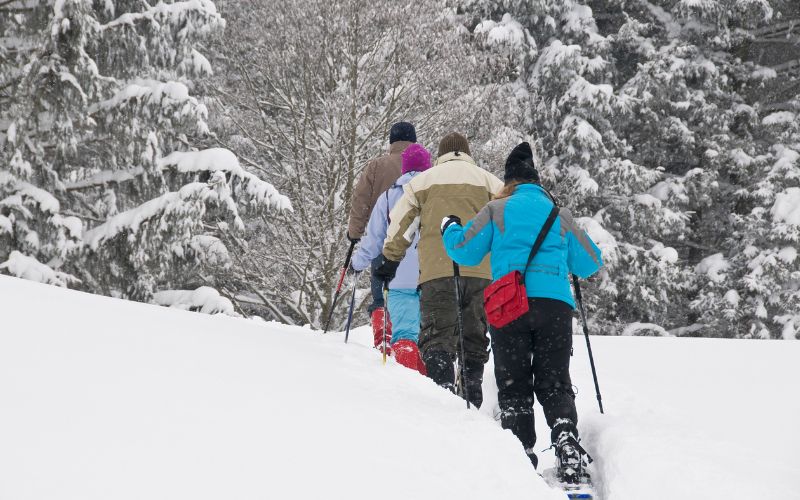
What To Look For In Snowshoeing Boots?
When choosing your ideal snowshoe boot keep in mind the key features listed below.
- Insulation
- Waterproofing
- Support
- Breathability
- Weight
Insulation
The insulation needed depends on how cold you expect conditions to get. Keep in mind that everyone feels the cold differently. If your feet tend to run cold, opt for better-insulated boots. Conversely, if your feet often sweat excessively on hikes, a lighter, less insulated model will likely suffice.
For hitting the white stuff in seriously frigid conditions, you want a well-insulated boot like the Keen Revel IV Polar or Baffin Impact, which is fit for forays to environments as chilly as the Arctic Circle. If you’ll be heading out in temps in the 15-35 °F range, a lightly insulated boot like the Oboz Bridger or Vasque Breeze WT GTX will do the trick and prevent your feet from overheating.
Another factor to consider is what kind of snowshoeing you plan on doing. If you are racing or simply tend to move at a fast clip, then it’s wise to opt for a boot that places more of an emphasis on breathability and performance than insulation. For this, we recommend a sleek, lightweight, performance-oriented boot like the Vasque Breeze or Merrell Thermo Chill.
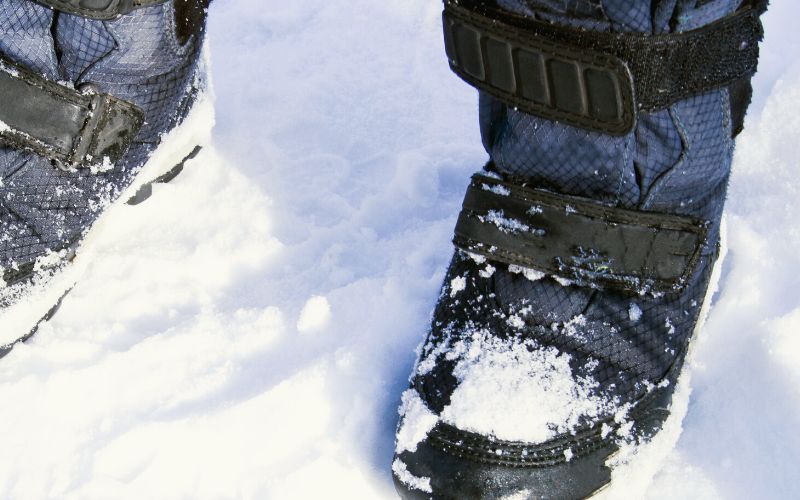
Waterproofing
Snowshoes are designed to keep us above the snow, however, our boots will frequently come into contact with the white stuff which is why waterproofing is still important. To keep your feet dry, most snowshoeing boots use a waterproof membrane between the upper and the insulating layer. Others rely on sealed seams, PU-coated uppers, or naturally waterproof leather.
All of the models above kept our feet bone dry in testing, though we should mention that most of that testing was done in powdery, dry snow. If out in slushy snow, our go-to snowshoeing boot is the Vasque Breeze, which uses a Gore-Tex membrane to complement its DWR-coated upper.
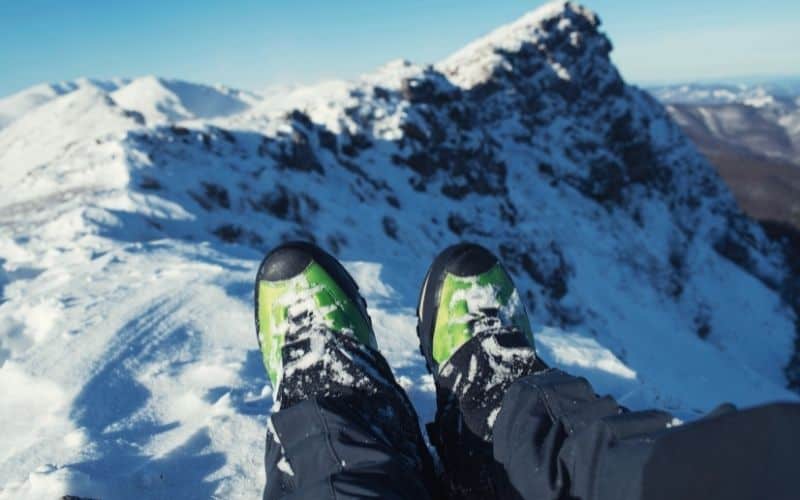
Support
As with regular winter hiking boots, key features in snowshoeing boots include ankle support, arch support, cushioning, supportive insoles, and heel support. Ankle support comes mainly from the rigidity of the upper, while arch support and cushioning are provided by the midsole. Heel support is determined by the deep and firm heel cup and heel counter.
In the field, we found all of the models we tested offered ample support throughout the foot and ankles, though the Merrell Thermo Chill’s mid-height cut made them feel a little less supportive than others. The three standouts were the Vasque Breeze, Baffin Impact, and KEEN Revel IV Polar.
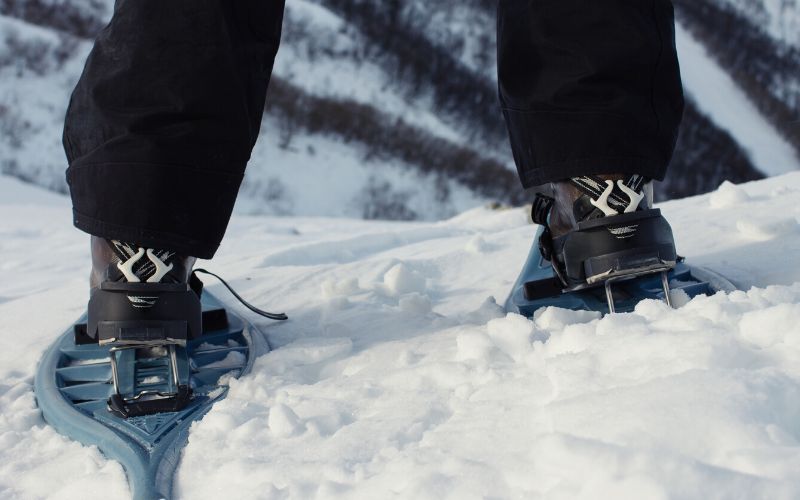
Breathability
A good boot shouldn’t only prevent cold air and moisture from entering but also have breathability to allow moisture (i.e. sweat) to escape. Otherwise, your feet are likely to become soaked with sweat when moving quickly, uphill, or in warmer temperatures resulting in discomfort and an increased risk of blisters. Furthermore, when sweat cools down it conducts heat away from the body more quickly than air so you’ll start to feel the chill even more.
Here’s the rub: as important as waterproof membranes and insulation are, boots that use them are typically less breathable than those that don’t (the Vasque Breeze are a notable exception). Given this, you might want to choose a boot with no membrane and lighter insulation, like the Columbia Bugaboot, if you plan on snowshoeing in warmer temps or tend to move fast.
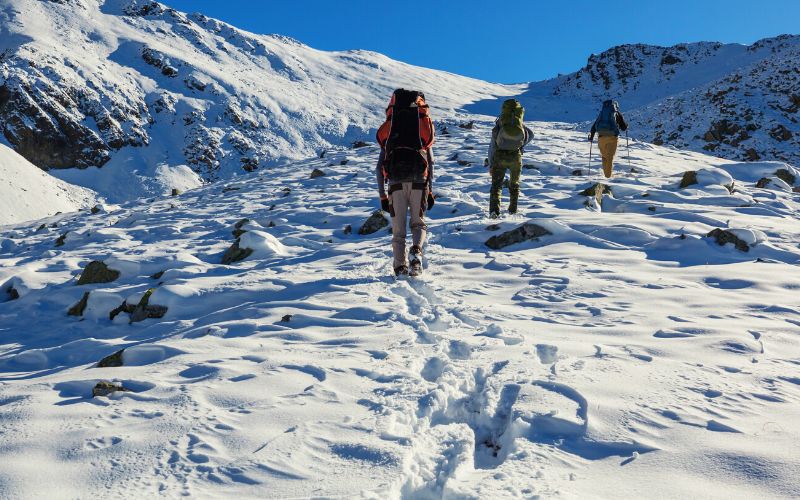
Weight
Newcomers to snowshoeing quickly notice the added strain placed on their legs due to the added weight on their feet. This extra weight primarily comes from the insulation and waterproofing.
A good example of this is found in the lightest and heaviest models on our list, the Columbia Bugaboot (1.85 lbs.) and Baffin Impact (7.42 lbs.). The Baffin is the warmest and one of the most waterproof boots on our list, whilst the Bugaboot is only lightly insulated and better described as water-resistant as opposed to waterproof.
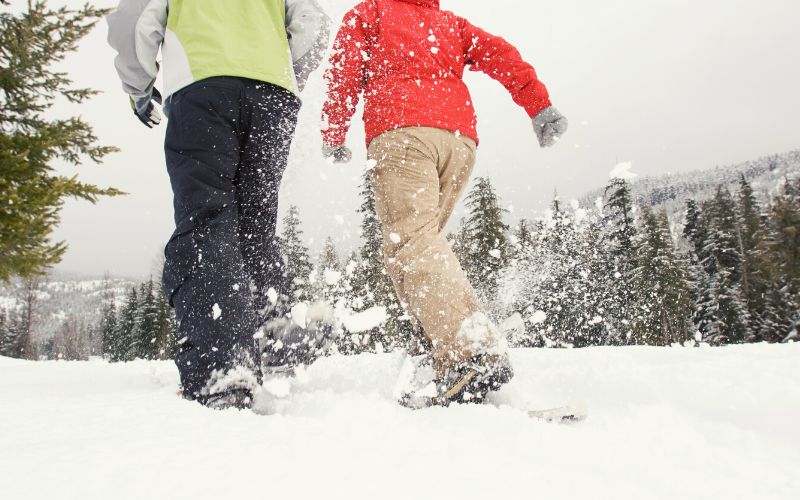
Are There Different Types of Snowshoes?
There are three primary types of snowshoes designed for flat terrain, rolling terrain, and mountain terrain. Choosing the right type depends on the intended use, skill level, and the specific characteristics of the winter terrain you plan to explore.
Traditional or flat terrain snowshoes are ideal for beginners and recreational snowshoeing on flat, groomed trails. These have a shorter length with a simple binding system and traction design to provide stability and ease of use.
Rolling terrain snowshoes are designed for varied landscapes, including hills and moderate slopes. They are typically longer, and feature rotating or floating bindings for better adjustment in changing terrain, a more aggressive crampon, and a moderate heel lift allowing for improved maneuverability on uneven surfaces.
Finally, mountain or alpine snowshoes are engineered for challenging, steep terrains and alpine environments. These feature rotating or floating bindings, aggressive crampons, and a high heel lift to aid uphill climbs and downhill descents.
Best Winter Boots For Hiking And Snowshoeing: The Verdict
While all the options on our list of the best boots for snowshoeing will serve you well on your winter adventures, the Keen Revel IV Polar is our top choice. This boot excelled in every category, particularly for comfort and agility. If you require a little more insulation, the Baffin Impact are a better option. And if your budget won’t stretch to either of these, the Columbia Bugaboot III are a solid alternative.
Our favorite women’s models are the Keen Greta, though we were also mightily impressed by The North Face Chilkat 400 and are huge fans of the women’s version of the Keen Revel IV Polar.
If you liked this post, let us know in the comments box below! And if you’d like to share it with your friends, share away!
